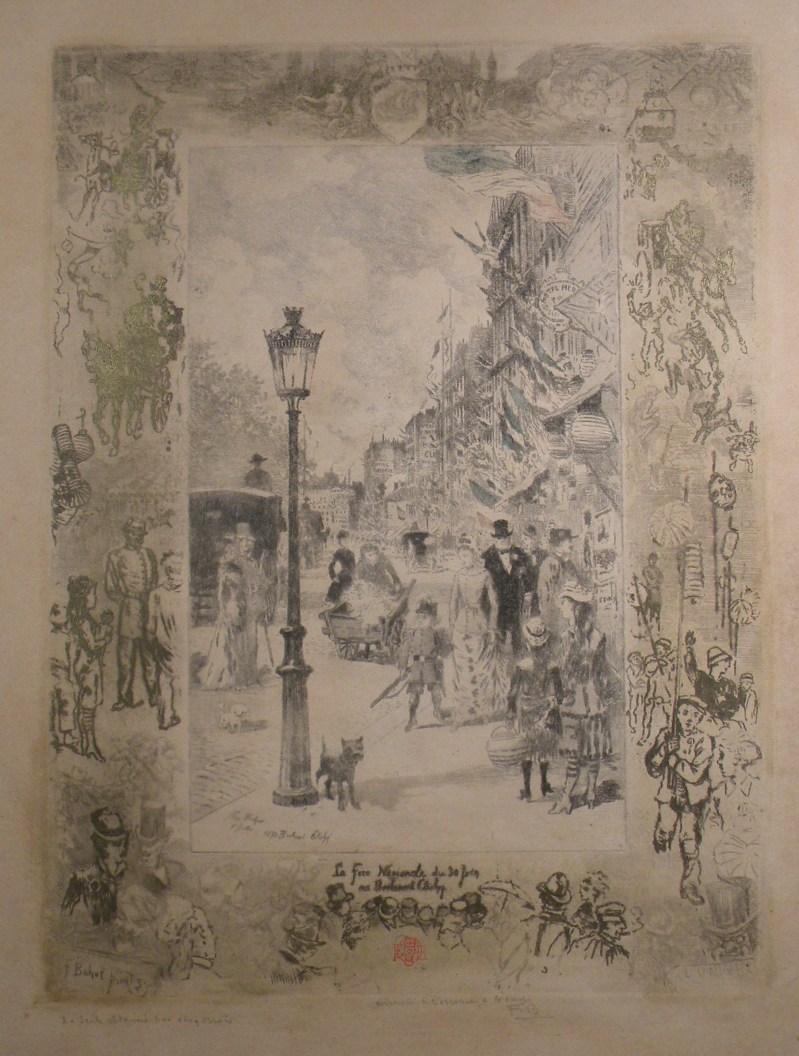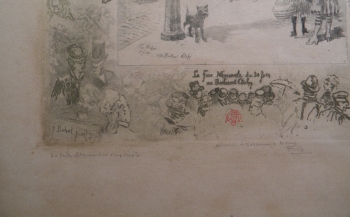Félix BUHOT: La Fête nationale au Boulevard Clichy - 1878
SOLD
[National Holiday on the Boulevard Clichy]
Etching, drypoint and aquatint, 320 x 238 mm (subject). Bourcard/Goodfriend 127 vii/viii, before cancellation.
Exceptional proof printed à l’essence in colors with symphonic margins in gold, on wove paper. Inscribed bottom in pencil by Buhot La Seule obtenue sur cinq essais [The only one achieved in five attempts] and epreuve à l’essence à 4 tons [printed in 4 colors on a paper soaked with turpentine] signed F.B and inscribed in the lower right corner Fete. ep. directe. Bears the red owl stamp within the subject (Lugt 977) Ex collection Roger Marx (Lugt 2229) and Emile Laffon (Lugt 877a).
A few small handling creases. The sheet slightly crinkles. Otherwise in very good condition. Good margins (sheet: 423 x 301 mm).
G. Bourcard notes that: “some impressions were printed with greyish-brown margins, and again by Ardail some rare copies in 4 colors with margins in gold” (Félix Buhot, Catalogue Descriptif de son OEuvre Gravé, with additions and revisions by James Goodfriend, New York, 1979, p. 77). The catalog of the Atelier Felix Buhot sale (Drouot, Dec. 2, 1977, lot 31) describes an impression “imprimée en couleurs, avec les marges tirées en or” [printed in colors with margins in gold] and annotated: une des six épreuves en couleurs [one of six impressions in colors]. One of these 6 impressions in colors is held by the Bibliothèque nationale de France (donation Félix Buhot, 1979). It is reproduced in L’Estampe impressionniste, M. Melot, Flammarion, 1994, p. 135. A third impression is presented by C. & J. Goodfriend in their online catalog Félix, Auguste and friends, no. 13. A fourth is listed in the posthumous sales catalog of the Roger Marx prints collection (no. 182): “très rare épreuve tirée à l'essence à 4 tons avec dédicace” [very rare impression à l’essence in 4 colors with a dedication] (Vente Collection Roger Marx, April 27 – May 2, 1914). The sale catalog of the Emile Laffon collection lists an impression “tirée en 4 tons, avec les marges symphoniques dorées, timbrée, signée, dédicacée (collection R. Marx)” [printed in 4 colors, with symphonic margins in gold, stamped, signed, dedicated] (Vente Emile Laffon, Zurich, April 7 and 8, 1938, no. 220). It is probably the same proof described in the Roger Marx collection, where the margins printed in gold were not mentioned, whereas here the printing à l'essence wasn’t pointed out.
Michel Melot has pointed out Buhot’s interest in printing à l’essence: “The height of refinement was reached as the proof was printed on a paper slightly soaked with turpentine, and the margins were painted in gold, as if the print were intended for a Des Esseintes…” (op. cit., p. 138, translated by us). Félix Buhot himself described the process: “Here is the method used: the sheet of paper must be soaked in turpentine, enough that it doesn't need to be wet by other means; and just before printing, it must be dried between sheets of paper which become filled with turpentine and therefore can also be used for printing: otherwise the proofs would be too dark and muddy. Thus, the paper will clean the plate. But we get yet another result. When papers are of good quality and well-selected, the turpentine gives them a beautiful parchment tone from which results some harmony. The paper also gets the texture of parchment.” (O. Uzanne, “Un illustrateur aquafortiste : Félix Buhot”, in Le Livre, Revue du monde littéraire, no. 99, March 1888, pp. 65-84, translated by us).
As James Goodfriend observed, most impressions à l’essence are “so different from our general idea of what an etching should look like that we have to get used to them before we can appreciate their beauty.” (op. cit., introduction). Buhot’s inscription on this impression: La Seule obtenue sur cinq essais [The only one achieved in five attempts], as well as his owl stamp and signature, attest that the ethereal colors and the light impression due to the paper à l’essence recreate the atmosphere he was looking for at that time.




